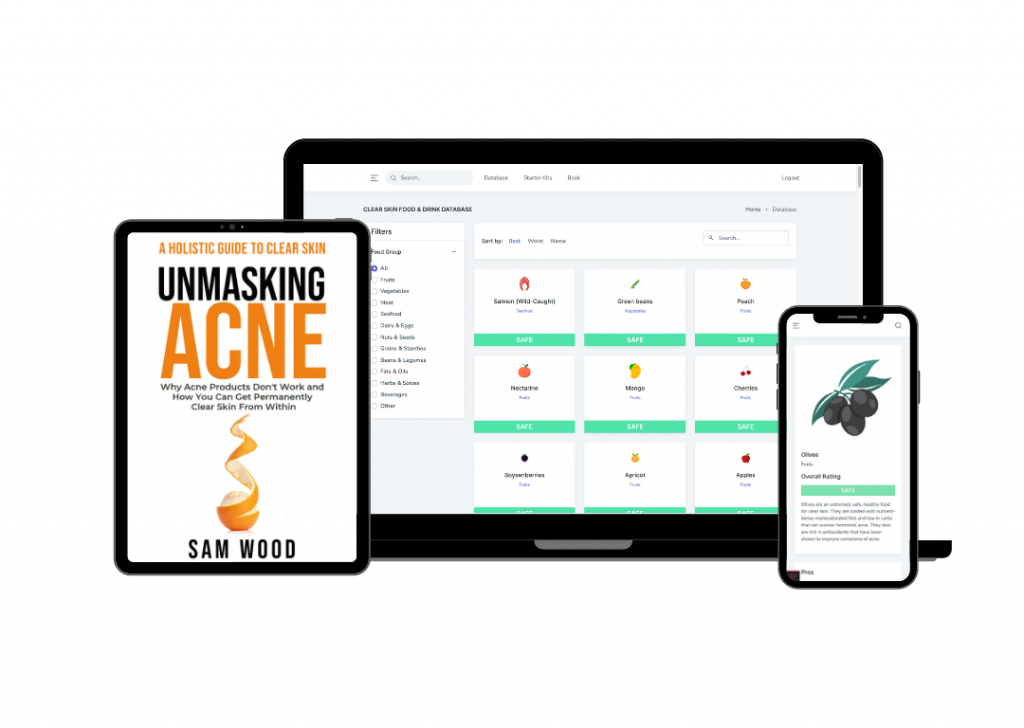Chamomile is a popular herbal tea sourced from the Asteraceae plant family. It’s been used in alternative and natural medicine for thousands of years, having been touted as a natural remedy for managing stress, healing open wounds, improving sleep quality and reducing painful period cramps.
Additionally, there are a multitude of skin benefits offered by both ingestion and topical application of chamomile, specifically healing and mitigating the effects of acne breakouts. In this article we will review how chamomile can decrease inflammation in the skin, reduce signs of aging and sun damage, brighten the skin, and heal wounds that develop in the aftermath of ruptured acne breakouts
1. Chamomile tea is anti-inflammatory
There are three key compounds that are responsible for chamomile’s anti-inflammatory, and antioxidant properties: they are known as chamazulene, matricin, and bisabolol, which all help heal and protect the skin from scarring, free radical damage, UV damage, dark spots, fine lines, and other signs of aging.
Because acne is an inflammatory condition of the skin, both ingesting and consuming the antioxidants contained in chamomile can help reduce acne breakouts.
2. Chamomile tea anti-aging
Chamomile is a natural anti-aging ingredient, as it contains astringent properties that help speed up the skin cell renewal process which helps heal acne breakouts more quickly and reduces the appearance of fine lines and wrinkles. Combining chamomile with potent anti-aging products such as non-comedogenic retinol would significantly boost any anti-aging skincare regime and accelerate any acne treatment.
3. Chamomile helps reduce UV Damage
Topical application of chamomile oil or tea can help reduce visible signs of UV damage. UV damage breaks down the collagen in the skin cells, which causes the pores to open up over time. Because chamomile is an astringent, it will help promote collagen production in the skin and reduce the likelihood of the pores clogging from oil, dirt, or other external factors. If your skin shows visible sun damage, you can apply a skincare product infused with chamomile extract can help reduce the effects and appearance of sun damage on your skin.
4. Chamomile brightens the skin
Chamomile’s antioxidant and moisturizing properties can help brighten skin tones by significantly reducing the appearance of dark spots, acne scarring and other signs of aging. Acne scars and dark spots tend to fade more quickly on properly hydrated skin. This is why many people make DIY face masks and toners with chamomile oil.
5. Chamomile promotes wound healing
Chamomile tea is a natural antiseptic and has been used for treating cuts, scrapes, and wounds for hundreds of years. If a zit or pimple ruptures on your skin a topical chamomile product application is a great natural alternative to abrasive chemicals which promise to “kill acne bacteria,” although they like kill healthy bacteria in the process and dry out your skin.
How many kinds of chamomile tea are there?
There are three primary types of chamomile plants that are used for human consumption (although there are 8-10 total) When it comes to chamomile teas and chamomile skin products, you can expect to find two key types of chamomile used:
1. Roman chamomile (also known as Anthemis nobilis)
Roman chamomile might also be referred to as “true chamomile” or “English chamomile,” and is used in a wide array of cosmetic products, as well as herbal chamomile teas.
2. German chamomile (also known as Maricaria recutita)
German chamomile is often referred to as “false chamomile”, yet is widely used in both cosmetic and herbal chamomile products. German chamomile contains a higher concentration of chamazulene, an essential oil in both german and roman chamomile.
3. Dyer’s chamomile (Anthemis tinctoria)
Dryer’s chamomile is not typically used for tea but is grown for its bright yellow flowers. As its name suggests, it’s historically been used as a source of yellow dye.
What other health benefits does chamomile tea have?
In addition to chamomile’s numerous skin benefits, it contains a wide variety of health benefits outside of skincare, including stress management, metabolism acceleration, and hormone optimization. In fact, chamomile has been used for thousands of years as a natural herbal remedy, chamomile tea has been used to treat the following health concerns:
- Improve symptoms of PMS and other related period pain
- Aid in sleep and relaxation
- Help manage diabetes in place of prescriptions like metformin
- Improve symptoms related to osteoporosis
- Curb hunger cravings and aid in weight loss
- Ease symptoms of common colds and fevers
Is it best to drink chamomile tea or apply it topically?
Chamomile can be used as a topical product (such as a manufactured skincare product infused with chamomile essential oils) or as a daily herbal tea. The best form of chamomile to take depends largely on your desired health outcome. Below we have a few examples of when it makes the most sense to apply chamomile topically vs drinking chamomile as a tea.
Chamomile Tea (Drink)
For an all-over antioxidant kick, I’d recommend drinking high-quality chamomile tea. While it might not be as potent a herbal tea as matcha tea (at least, when it comes to overall antioxidant benefits) chamomile tea is nonetheless a great all-rounder at providing natural anti-inflammatory benefits and a boost to the immune system. In addition, if your acne is linked to your hormones and you suffer from heavy periods, drinking chamomile tea can provide some pain relief, and even help to stabilize your cycle.
How often can I drink chamomile tea for acne?
There’s no limit on how much chamomile tea you can drink per day. Most experts would recommend around 1-2 cups a day if you want to truly feel the benefits of the herbal tea.
Chamomile Topical Application
If you want to deliver the antioxidant benefits of chamomile directly to any problem areas on the skin, I’d recommend using topical skincare products. As I already mentioned, one of the best chamomile skincare products I’ve used this year was Clearstem’s Vitamin Infused Scrub Cleanser. However, if you’re looking for something with a higher concentration of chamomile, you might want to opt for a skin spray. Unlike wash-off cleansers, skin sprays sit on your face and can deliver a higher dose of key ingredients to the skin. One of my go-to skincare brands is Mario Badescu, and their Aloe, Chamomile and Lavender facial spray is ideal if you want something natural and lightweight to soothe and hydrate the skin. This spray is super soothing, and won’t clog the pores with any heavy ingredients.
How to make your own chamomile oil DIY toner
If you don’t want to apply any manufactured skincare products to your skin and prefer to keep things natural, you can create your own DIY chamomile toner. You can switch up ingredients if you have any allergies, but one of the most popular DIY chamomile toners is made as follows:
- Gather one tablespoon of chamomile tea flowers or a chamomile tea bag, 1 cup of water, 1 teaspoon of honey, and 3-5 tablespoons of apple cider vinegar.
- Boil the tea, before letting it steep for around 10 minutes.
- Strain the tea, before adding the apple cider vinegar and honey to the tea.
- Using cotton pads, apply the DIY toner to the face after cleansing, before applying your moisturizer.
Is chamomile oil comedogenic?
No, chamomile oil is not comedogenic and does not clog the pores on its own. However, if you are buying a “chamomile-infused product” from the store make sure to check the product for comedogenic ingredients to make sure there is nothing in the product that will clog the pores of trigger an acne breakout.
Is chamomile oil safe for fungal acne?
Yes, chamomile tea is safe to use on fungal acne-prone skin. Chamomile oil is antifungal and antiseptic, which makes it difficult for malasseiza yeast to grow on the skin when using the oil. This fungal acne-safe face wash contains chamomile oil and is a great cleanser option for anyone dealing with fungal acne.
Does chamomile tea have any side effects?
No, chamomile tea does not have any side effects. Although most teas are generally considered beneficial for health, some teas, like spearmint tea, can cause hormonal fluctuations that help women alleviate symptoms of PCOS, but lower testosterone to a sub-optimal level for men.
What is the best way to reduce acne breakouts?
The best way to reduce acne breakouts is to follow a “healthy-lifestyle” that can be summarized by the following:
- Follow a healthy, low-inflammation diet
- Exercise regularly
- Get quality sleep
- Avoid using comedogenic skincare products
- Change your pillowcases 2-3 times per week
I suffered from acne breakouts for over ten years and tried hundreds of skincare products, diets, and other fads, that simply do not work for most people. Eventually, I came up with a clear skin protocol that completely cleared my skin (and now over 2,000 others as well).

